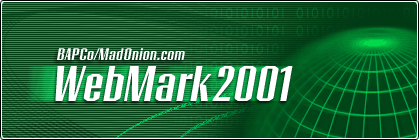AMD Athlon "Thunderbird" 1.33GHz/1.30GHz
by Anand Lal Shimpi on March 22, 2001 4:52 AM EST- Posted in
- CPUs
New Tests (continued)
WebMark 2001
When BAPCo released WebMark 2001 we were highly skeptical of its usefulness, how often do you complain about how slow your CPU is in rendering a web page? It turns out that WebMark 2001 is much more than a series of timed web page loads, it's actually more of a technology benchmark. The suite takes into account performance under commonly used applications such as Acrobat Reader, Quicktime, Real Player, Windows Media Player as well as performance in running Java applications, XML/VML rendering and much more. The benchmark even simulates real world behavior by having chat windows open while typing in a Word document, while browsing the Web among other things.

The benchmark is much more complicated to setup than SYSMark or any other benchmark for that matter. It requires a Server and a Client machine; the Server must be running either Windows NT Server or Windows 2000 Server. Luckily, we were in the middle of building a fifth server for the AnandTech Forums and adapted that server, which runs Windows 2000 Server, for use with the WebMark 2001 benchmark.
The performance of the server does not impact the performance of the client machine in this test, provided that the server is fast enough. In this case, the 1GHz Athlon that was used in the server with its 512MB of PC133 SDRAM and 100Mbit Ethernet cards on the 100Mbit switched LAN in the lab was more than enough for the test. If you're curious as to what is necessary to setup the server portion of the benchmark, check out this page that explains the process.
The client is then loaded with the WebMark 2001 client-software as well as copies of Adobe Acrobat, Microsoft Media Encoder, Microsoft Agent, Macromedia Flash, Apple Quicktime, Real Networks Real Player, Microsoft Media Player, and Cycore Cult 3D (3D web visualization software). These technologies combined with Java, HTML/DHTML, ASP, Perl, SSL, VML and XML are used in a total of 7 mockup web sites and are used to measure the web performance of the client system.
A description of the 7 web sites taken from BAPCo's WebMark 2001 Whitepaper:
|
eHouseBuilder |
A web marketplace for building supply parts and interactive tools for house builders |
|
electronics-designer |
The online arm of an electronics design company that allows other engineers to learn detailed information about integrating electronics-designer’s products. |
|
eMedInsure |
The website for a medical insurance company which receives and processes insurance claims. Doctors who work for eMedInsure approve or reject claims after studying medical data |
|
eCommodity-Traders |
An online brokerage house that assists traders in trading with other agencies by providing trading services and information utilities like charts and prediction models |
|
SuperEtailer |
An online shopping site offering a highly interactive experience to resemble that of an actual brick-and-mortar store |
|
My-Foyer |
A personalized online news and data center that provides a quick summary of the users favorite topics as well as links to interactive and media-rich sites that provide more detailed information. |
|
Auto-Concepts |
An automobile corporate intranet website. This workload both creates online documents with Office 2000* applications and Windows Media Encoder* and views these documents. |
WebMark 2001 features two types of web-based transactions according to BAPCo: Result based transactions (where the user submits a request and waits for a result, like a web page load), and Media-based animation transactions (e.g. Flash, VML, etc…).
The scores generated from the benchmark include an overall score that is then split into three separate categories: Business to Business (B2B) transactions, Business to Consumer (B2C) transactions, and Business transactions (B) such as those you'd find occurring over a corporate Intranet.
The WebMark 2001 Technology run is another benchmark contained within the WebMark suite and it simply offers performance figures in the following categories:
· Loads in Average Load Time
· XML processing in XML Operations per Second
· Video playback measured as CPU Utilization (smaller is better)
· Java applications in Java Operations per Second
· VML in Average Response Time
· 3D visualization in Frames per Second
· Flash animations Frames per Second
· Flash applications in Average Response Time
While the benchmark does paint an interesting perspective on processor performance, there is one major flaw, and that being that systems are still generally bottlenecked by their connection to the Internet before they are CPU limited in their web performance. At the same time, very few pages are as intensive as those exemplified in WebMark 2001. If anything, allow WebMark 2001 to provide an insight into what may be, not what currently is.
Why are we using it? Because it provides us with another method of looking at performance and extrapolating more information regarding the architecture of the CPUs we are comparing here today.










1 Comments
View All Comments
youcanyouwill - Sunday, January 5, 2020 - link
Thanks for sharing. https://www.carngo.com/car-rental/south-africa-nel...